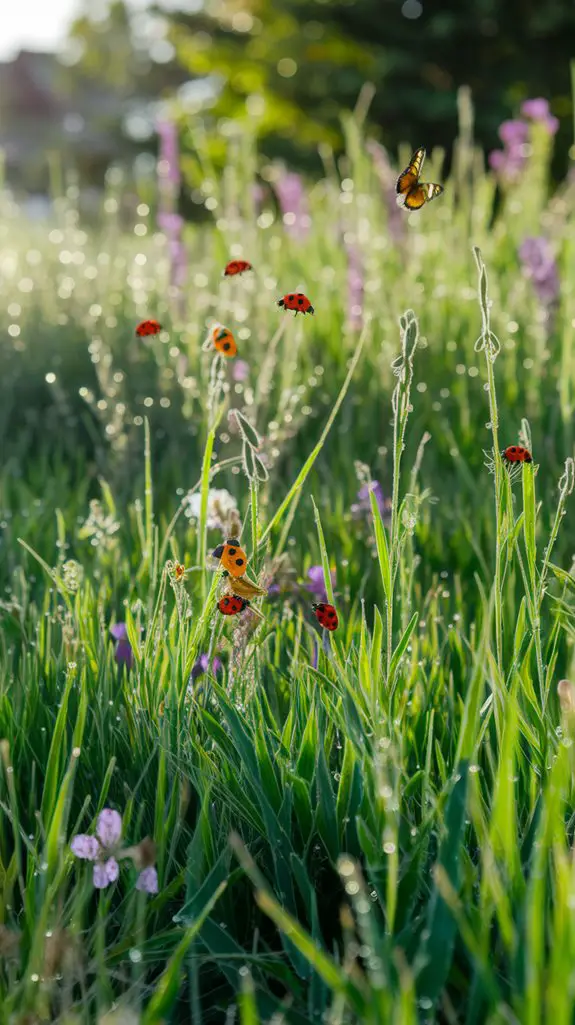You’re fighting an uphill battle with synthetic lawn care products that damage soil biology and create chemical dependencies. Instead, shift to natural methods that work with nature’s systems rather than against them. Start by understanding your soil’s unique profile through thorough testing – it’s the foundation upon which all successful organic lawn care builds. The secrets to lush, resilient turf without harmful chemicals await in the natural alternatives that professionals have refined for decades.
Soil Testing and Natural Amendment Strategies
Before starting on any natural lawn care regimen, you’ll need to conduct a thorough soil test to establish your baseline conditions.
Purchase a quality pH testing kit or send samples to your local extension office for extensive analysis including nutrient levels and organic matter content.
For acidic soils (pH below 6.0), incorporate dolomite lime at 20-40 pounds per 1,000 square feet.
If your soil tests alkaline, elemental sulfur will gradually lower pH.
Address nutrient deficiencies with targeted organic amendments: bone meal (phosphorus), greensand (potassium), and blood meal (nitrogen).
Improve soil structure by topdressing with ¼-inch compost annually.
Clay soils benefit from gypsum applications, while sandy soils require additional organic matter to improve water retention.
Always calibrate amendment quantities based on your specific test results. Additionally, vegetable gardening in small spaces can offer creative ways to maximize your yard’s productivity.
Chemical-Free Weed Management Techniques

Why struggle with synthetic herbicides when effective chemical-free alternatives exist? Focus on manual extraction for established weeds, using a long-handled weed puller to remove taproots completely.
Apply corn gluten meal (CGM) at 20 pounds per 1,000 square feet in early spring as a pre-emergent barrier that inhibits root formation in germinating seeds.
Enhance cultural practices by maintaining grass at 3-4 inches tall, which creates shade that suppresses weed germination. Overseed thin areas with appropriate grass varieties at 4-6 pounds per 1,000 square feet to establish dense turf.
For spot treatments, apply boiling water or vinegar solution (1:1 ratio with water) directly to weed foliage, avoiding contact with desired plants. Flame weeding with propane torches effectively eliminates weeds in walkways and driveway cracks.
Incorporating safe lawn practices not only promotes a healthier environment but also ensures that your lawn remains a safe space for children to play.
Eco-Friendly Pest Control Solutions

Maintaining an ecological balance in your lawn requires targeted pest management strategies that preserve beneficial organisms. Implement integrated pest management (IPM) principles by first identifying specific pests before intervention.
| Pest Type | Natural Control Method | Application Frequency |
|---|---|---|
| Grubs | Beneficial nematodes | Bi-annually (spring/fall) |
| Aphids | Ladybug introduction | Once at first sighting |
| Chinch bugs | Diatomaceous earth | Monthly during warm seasons |
| Mosquitoes | Bt (Bacillus thuringiensis) dunks | Every 30 days in standing water |
You’ll achieve superior results by applying neem oil as a broad-spectrum deterrent during early morning hours when beneficial insects are less active. Introducing predatory insects like praying mantises creates a self-regulating ecosystem, while strategically placed birdhouses invites natural avian predators to manage crawling pests throughout your lawn. Additionally, utilizing organic pest control methods can enhance the health of your garden and promote biodiversity.
Water Conservation and Proper Irrigation Methods
Smart irrigation practices form the cornerstone of sustainable lawn management while considerably reducing water consumption.
Install moisture sensors to activate sprinklers only when soil moisture drops below ideal levels—typically 40-50% saturation. Water deeply (1-1.5 inches) but infrequently (1-2 times weekly) to encourage deeper root growth and drought resistance.
Position sprinkler heads strategically to avoid runoff, ensuring 100% coverage with minimal overlap. Program irrigation systems to operate between 4-6 AM when evaporation rates are lowest and wind interference is minimal.
Consider implementing drip irrigation for ornamental beds adjacent to lawn areas, achieving up to 90% efficiency compared to conventional sprinklers. Collect rainwater in barrels connected to downspouts, using this mineral-rich resource during dry cycles.
Adjust watering schedules seasonally—reducing frequency by 30-50% during cooler months. Additionally, maintaining a healthy lawn ecosystem can enhance the effectiveness of your irrigation efforts and support overall yard vitality.
Seasonal Maintenance Schedule for Organic Lawns
Just as irrigation practices adapt by season, a thorough organic lawn care calendar guarantees timely implementation of all maintenance activities throughout the year.
Begin spring with soil testing and core aeration when soil temperatures reach 55°F. Apply compost tea and overseed thin areas after the last frost date.
Summer maintenance requires raising your mower height to 3-4 inches and reducing mowing frequency during drought periods.
Apply corn gluten meal in late summer as a pre-emergent herbicide for fall weed prevention.
In autumn, focus on core aeration, topdressing with compost, and seeding cool-season grasses.
Apply kelp extract to strengthen root systems before winter dormancy. Budget-friendly lawn care techniques not only save money but also promote a healthier lawn.
Winter tasks include cleaning and sharpening equipment, planning next year’s organic fertilizer schedule, and avoiding foot traffic on frozen turf to prevent crown damage.
Conclusion
You’ve now acquired the hilariously complex science of letting your yard actually function as nature intended—what a revolutionary concept! You’ll certainly enjoy explaining to your chemically-dependent neighbors why you’re applying cornmeal instead of the latest synthetic compound with an unpronounceable name. Congratulations on your newfound status as the neighborhood’s soil microbiome enthusiast, where you’ll measure success not in perfectly uniform green blades, but in earthworm populations and mycorrhizal fungi colonization rates.




